Less is more: the Barcelona armchair by Ludwig Mies van der Rohe
“Please do not [confuse] simple with easy, there is a big difference. I love simplicity because of its clarity, not because of its ease or for any other reason [...] To achieve clarity we have to simplify practically everything. It is hard work. One has to fight, and fight, and fight.” With just a few words, Ludwig Mies van der Rohe (Aachen, 1886 - Chicago, 1969) summed up one of the pivotal principles of his life as an architect, designer, and architectural theorist, lived at the turn of the 19th and 20th centuries.
Ludwig Mies van der Rohe (whose surname is derived from the fusion of his father’s, Mies, and his mother’s, Rohe, joined by the Dutch particle van der) is rightly considered a milestone in the history of architecture and design because of his way of conceiving architecture and everything within it. The son of a stonemason and stonemason from Aachen, he was trained at a very young age through his father’s business: he learned about materials, especially marble, which would return endlessly in his production, and he became acquainted with the art of building. At the same time, it is his city that forms his vision of a clear, solid, true architecture: in the shadow of the Palatine Chapel, a medieval building, imposing and textural, located in a city growing thanks to the industrialization of the late nineteenth century, Mies realizes that “the strength of those buildings [impressed me] because they did not belong to any era. They had been there for more than a thousand years and they continued to be impressive. Nothing could change in them. All the great styles had passed, but they remained. They had lost nothing and were as fine as the day they were built. They were medieval buildings without any particular character, however, they were really built.” Thus began to take shape the idea that one cannot submit to the fashions of the moment, but that buildings should express deep meanings, communicating “the spirit of the time” in which they were built.

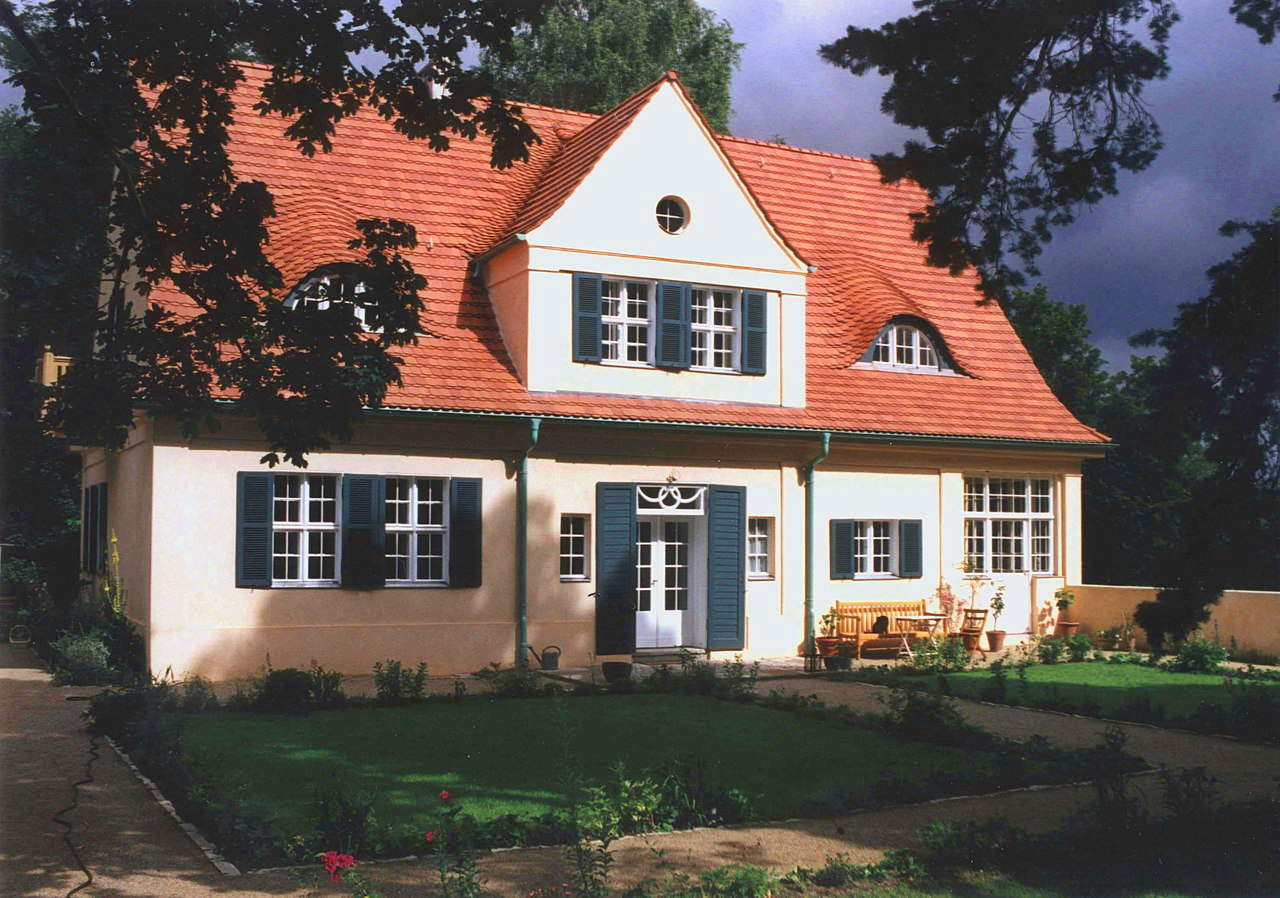
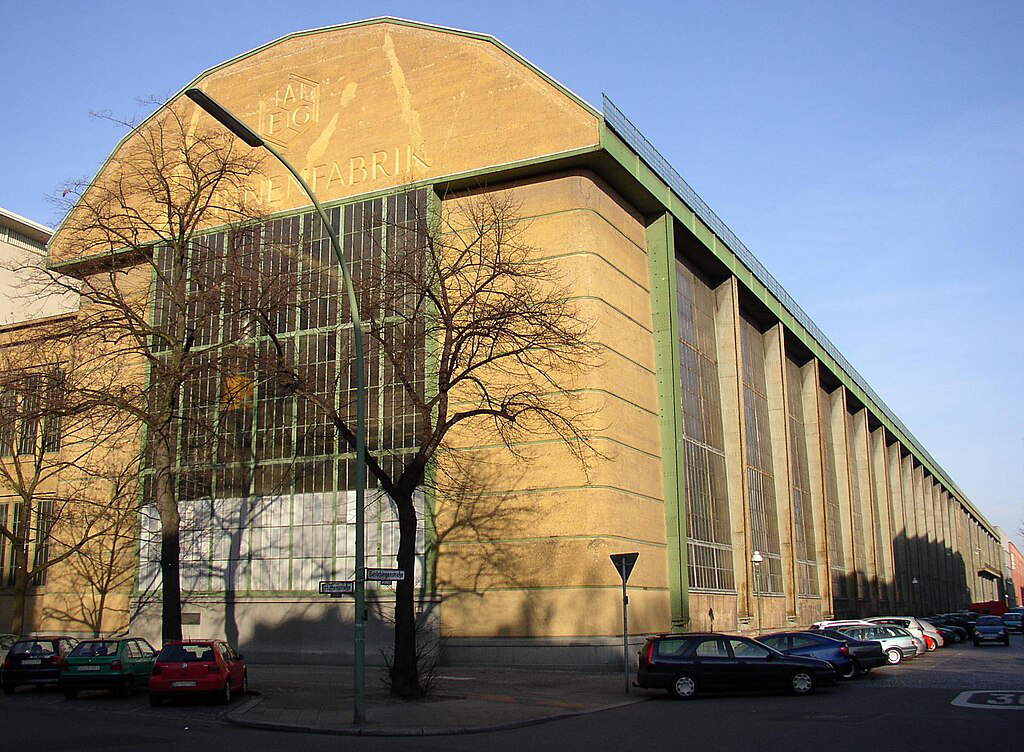
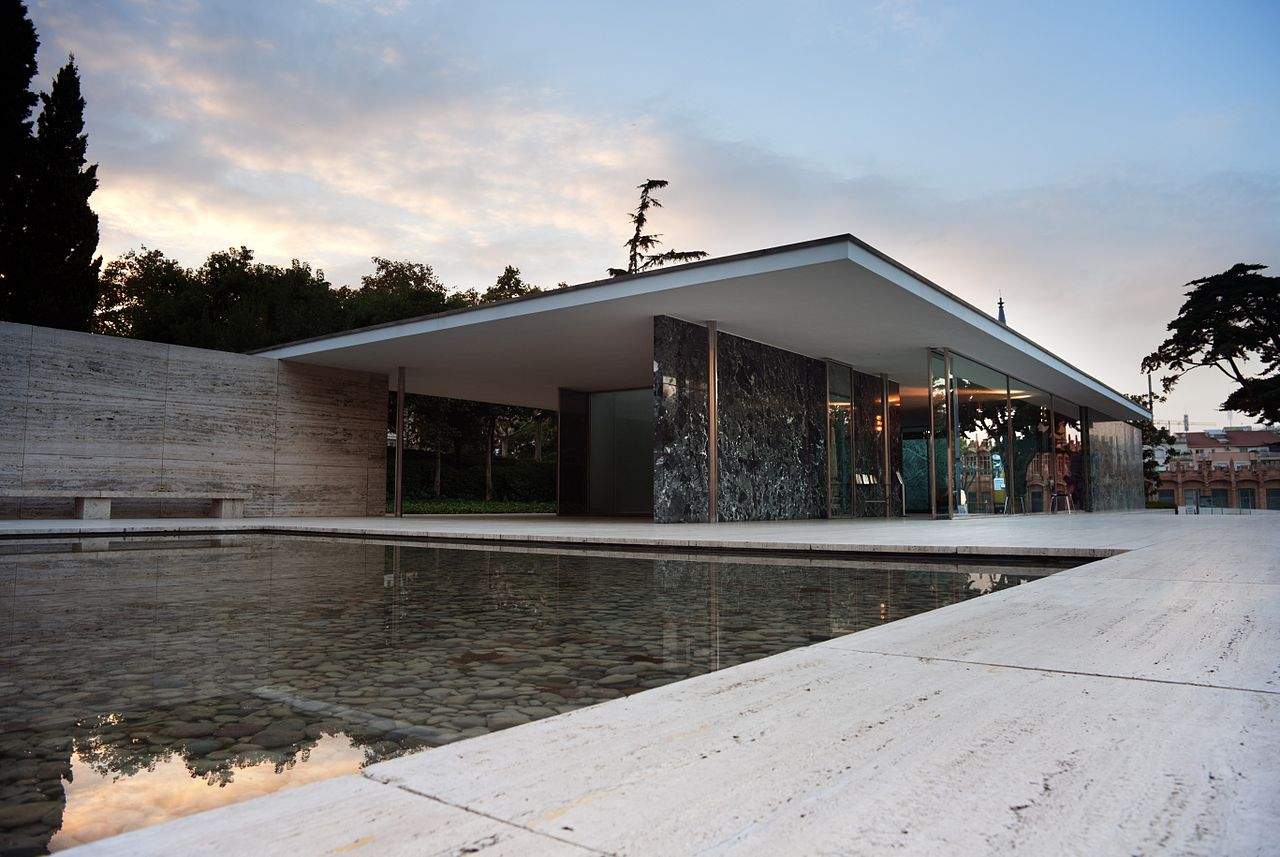
Mies’ training continued and he began to bring to life early projects, such as the Riehl House, in which an element, descended from classical architecture, appears in nuce that will always connote his architecture: the podium. A turning point is his meeting with Peter Behrens (Hamburg, 1868 - Berlin, 1940), an architect and designer with whom Mies worked from 1907 to 1912, sharing his thinking and working alongside him on important projects, not without some friction. Understanding the scope of Behrens’s work and its connection to Mies’s thinking is possible by looking at a building that epitomizes a specific idea of architecture: the AEG turbine factory in Berlin, designed by Behrens in 1908 for Germany’s largest electro-mechanical company at the time. An imposing building with simple and sober volumes, in which the structural elements are evident and denounce their functioning, without being masked by any kind of decoration; a building designed to house industry and created with the materials of industry, first and foremost glass; a kind of “temple” with an industrial matrix, as the large pediment on the facade declares.
This attention to the clarity of forms, to the simplification-but not trivialization-of elements, to the use of materials from a functional point of view, will influence so many protagonists of the Modern Movement, including, precisely, Mies, who develops an original thought, supported by a solid theoretical basis, convincing himself that form is the result of a process and not the only purpose, since “form as a purpose always leads to formalism.”
The work of reduction to essence also lands in Mies’ design: one example among all, the Barcelona armchair, which has become iconic. The setting for which it is designed is the Barcelona Pavilion, commissioned by the Weimar Republic to represent the “new Germany” at the 1929 World’s Fair in Barcelona. The commission was given to Mies, who in the meantime had continued to perfect himself, working on projects such as the monument to Otto von Bismark, one of his first photomontages (a technique he would master with great mastery) or the skyscraper for Friedrichstraße-the first in a series of projects that were never realized-which, with its crystallized plan, could recall the expressionist dream of glass architecture. By these dates Mies had become an established practitioner, and his theory of architecture had taken shape.
The Pavilion is an expression of those elements that would characterize, from here on, his future projects: the podium, the cruciform steel pillars, the steel and glass frames, the marble cladding, and, above all, the interpenetration between interior and exterior space, between man and nature. Indeed, the natural element is very important, in this case water, which is perceived through the presence of two tanks of different sizes. The Pavilion is a space characterized by the principle of the “free plan” (the main innovation introduced by Mies and other exponents of the Modern Movement, such as Le Corbusier) in which the visitor can move fluidly and in which the pillars and marble baffles determine the spaces while leaving their boundaries uncertain, never clearly dividing and never completely closing off from the outside. The pillars rest on a travertine podium and support the imposing flat roof, revealing that they themselves are the load-bearing elements, and no longer the walls. The refinement of the materials, precious and essential at the same time, such as the different types of marble that characterize the rooms, and extremely light and functional such as steel and glass, becomes a distinctive feature of Mies, who renounces any kind of tinsel and lets the material speak, according to his famous adage “less is more.”
It is in the main room of the Pavilion, characterized by a large slab of golden onyx, that the Barcelona armchair finds its place. An object created “with the means of its time” and representative of that time, just as its creator intended. It, in fact, is a product that sees the light of day thanks to the means of industry and materials that lend themselves to industrial processing. In fact, the frame is composed of tubular steel elements, which were the subject of research and experimentation in those very years, as demonstrated by the Wassily chair made by Marcel Breuer in 1925.

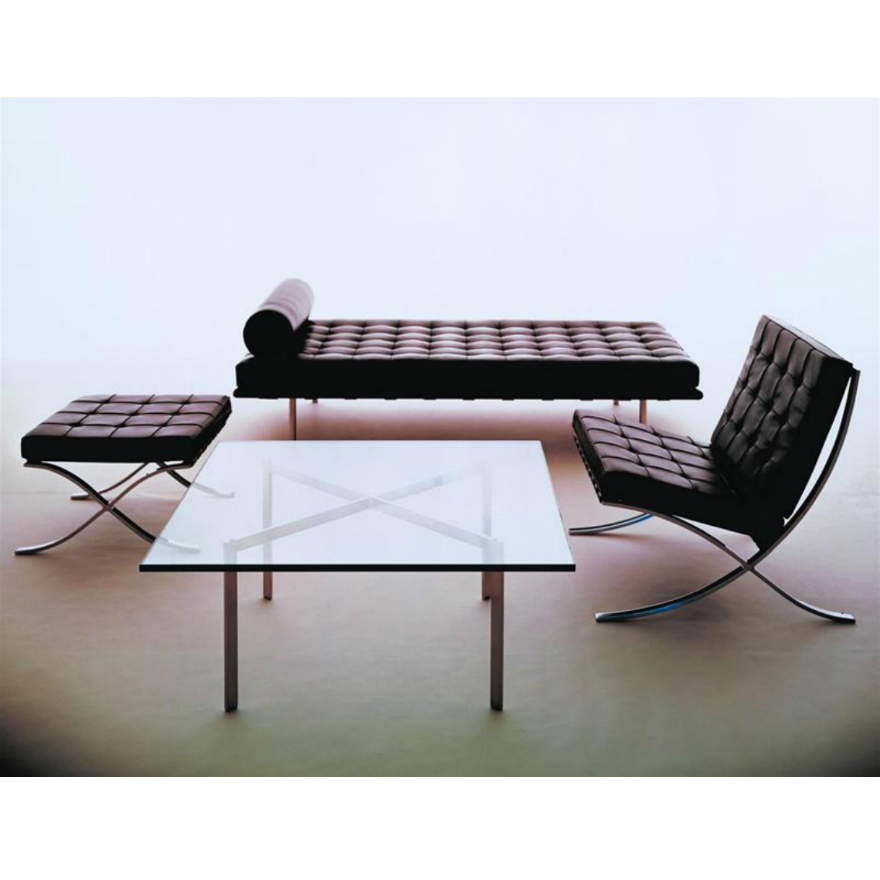
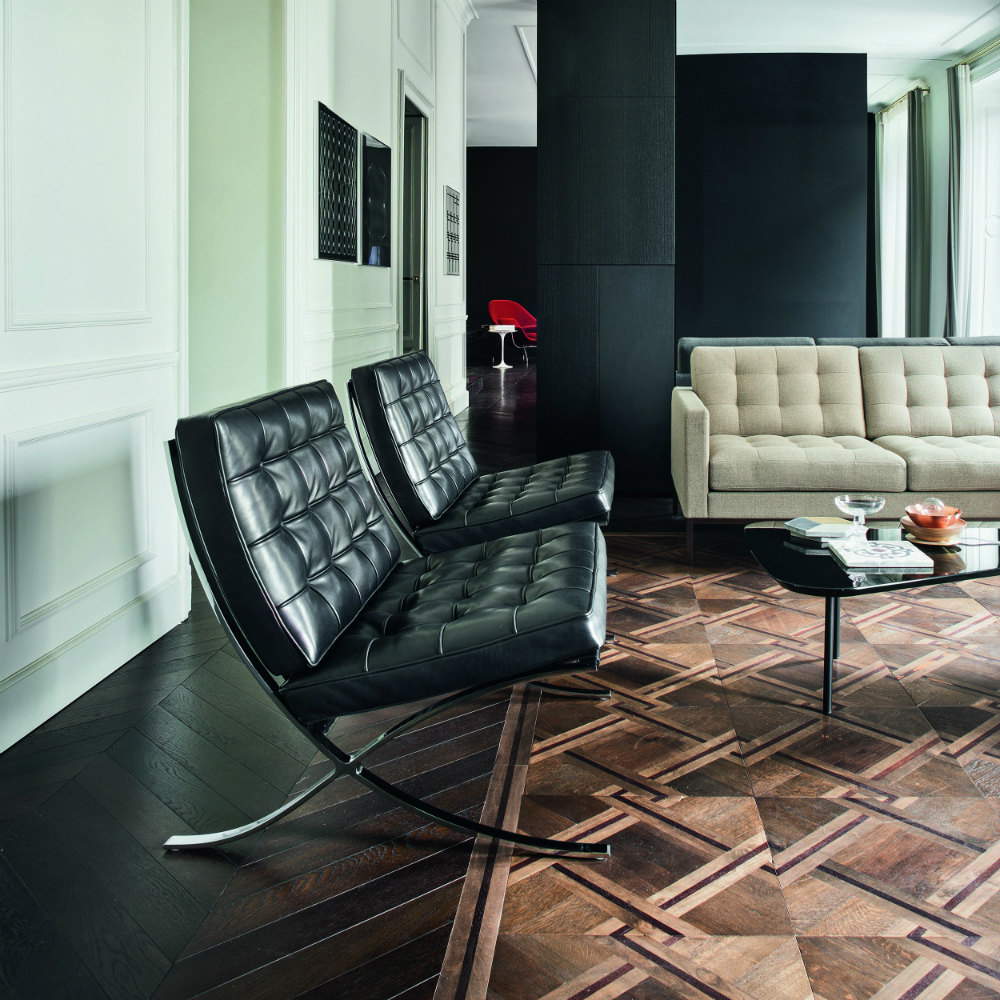
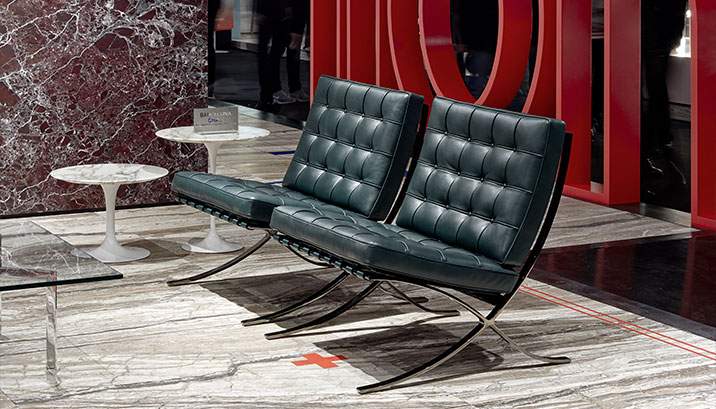
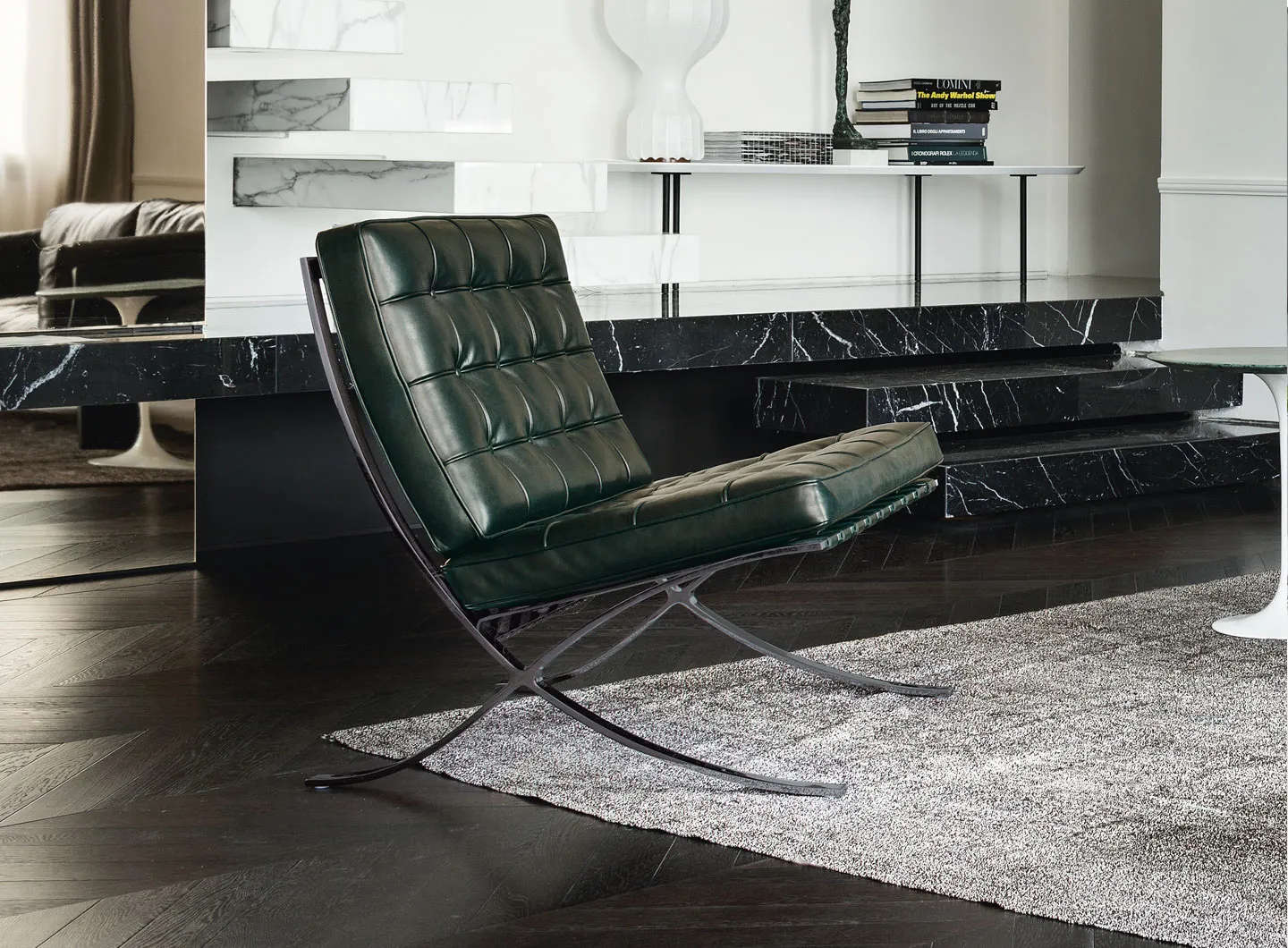
The neutral-toned seat and back cushions rest on the steel frame, hand-polished with a mirror finish, and supported by 17 strips of leather attached to it. Each cushion consists of 40 squares cut and welded by hand, quilted with leather buttons-a process that combines industrial workmanship with great craftsmanship. Two examples can be found in the Pavilion, accompanied by pairs of matching stools, designed specifically for the King and Queen of Spain to rest on while visiting the Exposition. In accomplishing this feat, however, Mies was not alone, but assisted by Lilly Reich (Berlin, 1885 - 1945), an architect, textile designer, very active in the field of exhibition design, one of the first and only women to have taught at the Bauhaus - of which Mies was to become director in the early 1930s - and co-author of many projects, including the Barcelona armchair itself.
But how does an object designed to be housed in such ephemeral architecture as a national pavilion come to the present day? It all comes about thanks to an encounter, that between Ludwig Mies van der Rohe and Florence Knoll (Saginaw, 1917 - Coral Gables, 2019), an architect and designer trained with the great masters of Bauhaus who emigrated to America, including Mies himself, who most of all passed on to her his approach to design: methodical and rigorous. In fact, the meeting between the two occurred during the long period Mies spent in America, due to Hitler’s rise in Europe, where he became a lecturer at the Illinois Institute of Technology in Chicago, where Knoll was a student. A relationship of friendship and mutual esteem developed between the two, which, in 1953, led Mies to personally cede the reproduction rights of the Barcelona armchair to Knoll Associates, a company run by Florence Knoll herself and her husband Hans. Thus Knoll, following to the letter the standards given by Mies, began to mass-produce, while retaining a strong craftsmanship component, one of the most symbolic objects not only of the company, but also of the Modern Movement and the history of design.
Warning: the translation into English of the original Italian article was created using automatic tools. We undertake to review all articles, but we do not guarantee the total absence of inaccuracies in the translation due to the program. You can find the original by clicking on the ITA button. If you find any mistake,please contact us.




























